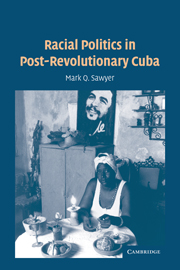Book contents
- Frontmatter
- Contents
- List of Figures and Tables
- Acknowledgments
- Introduction
- 1 Race Cycles, Racial Hierarchy, and Inclusionary Discrimination: A Dynamic Approach
- 2 Freedom and Discrimination: Uneven Inequality and Inclusion in Pre-Revolutionary Cuba
- 3 Race and Revolution: Transformation and Continuity
- 4 Match Made in Heaven or Strange Bedfellows? Black Radicals in Castro's Cuba
- 5 Race and Daily Life in Cuba During the Special Period: Part I: Interview Data
- 6 Race and Daily Life in Cuba During the Special Period: Part Ⅱ: Survey Research
- 7 Racial Politics in Miami: Ninety Miles and a World Away
- Conclusion
- Bibliography
- Index
7 - Racial Politics in Miami: Ninety Miles and a World Away
Published online by Cambridge University Press: 05 September 2012
- Frontmatter
- Contents
- List of Figures and Tables
- Acknowledgments
- Introduction
- 1 Race Cycles, Racial Hierarchy, and Inclusionary Discrimination: A Dynamic Approach
- 2 Freedom and Discrimination: Uneven Inequality and Inclusion in Pre-Revolutionary Cuba
- 3 Race and Revolution: Transformation and Continuity
- 4 Match Made in Heaven or Strange Bedfellows? Black Radicals in Castro's Cuba
- 5 Race and Daily Life in Cuba During the Special Period: Part I: Interview Data
- 6 Race and Daily Life in Cuba During the Special Period: Part Ⅱ: Survey Research
- 7 Racial Politics in Miami: Ninety Miles and a World Away
- Conclusion
- Bibliography
- Index
Summary
In May 1980, a race riot erupted in Miami following the acquittal of four white Miami police officers for the fatal beating of an African American businessman. The riots broke out in Liberty City, a predominantly black ghetto whose residents had grown weary of police brutality, poverty, and unemployment (Croucher 1997; Dunn 1997; M. C. Garcia 1996). According to the political scientist Sheila Croucher, “Over a three-day period entire neighborhoods were destroyed, fires set, windows broken, and homes and businesses looted” (4). Eighteen people were killed. The riots shocked the nation and resulted in property damage estimated at $200 million. The rioters were primarily African Americans, but they also included Afro-Cubans, Jamaicans, and Haitians (Dunn 1997).
Racial politics in Miami over the past twenty years has often been extremely tense. This tension is a product of divisions based on race, class, ethnicity, country of origin, and era of immigration. The riot highlighted the frustrations of blacks in Miami, who suffered the ongoing effects of an economic recession and watched as a white Cuban elite formed partnerships with a white Anglo elite for control of the city (Garcia 1996; Croucher 1997; Dunn 1997). A new wave of Cuban immigrants continued to arrive in the city, adding to the tension.
The Cuban Revolution is as much a part of the history of Miami as it is a part of Cuban history.
- Type
- Chapter
- Information
- Racial Politics in Post-Revolutionary Cuba , pp. 154 - 174Publisher: Cambridge University PressPrint publication year: 2005



